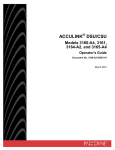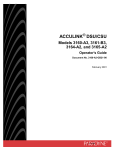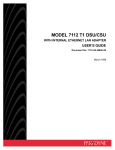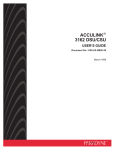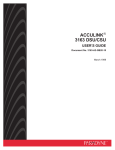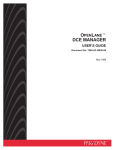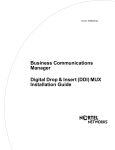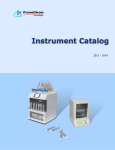Download Paradyne 3172 Network Card User Manual
Transcript
ACCULINK® 3172 and 3174 E1 DSU/CSU Quick Reference Document No. 3170-A2-GL10-10 Copyright © 2001 Paradyne Corporation. All rights reserved. Printed in U.S.A. Warranty, Sales, Service, and Training Information Contact your local sales representative, service representative, or distributor directly for any help needed. For additional information concerning warranty, sales, service, repair, installation, documentation, training, distributor locations, or Paradyne worldwide office locations, use one of the following methods: Internet: Visit the Paradyne World Wide Web site at www.paradyne.com. (Be sure to register your warranty at www.paradyne.com/warranty.) Telephone: Call our automated system to receive current information by fax or to speak with a company representative. — Within the U.S.A., call 1-800-870-2221 — Outside the U.S.A., call 1-727-530-2340 Document Feedback We welcome your comments and suggestions about this document. Please mail them to Technical Publications, Paradyne Corporation, 8545 126th Ave. N., Largo, FL 33773, or send e-mail to [email protected]. Include the number and title of this document in your correspondence. Please include your name and phone number if you are willing to provide additional information. Trademarks ACCULINK is a registered trademark of Paradyne Corporation. All other products and services mentioned herein are the trademarks, service marks, registered trademarks, or registered service marks of their respective owners. ACCULINK® 3172 and 3174 E1 DSU/CSU Quick Reference Document Number 3170-A2-GL10-10 July 2001 Product Documentation Online Complete documentation for this product is available at www.paradyne.com. Select Library → Technical Manuals → T1/E1 Digital Access Devices. Select the following document: 3170-A2-GB20 ACCULINK 3172 and 3174 E1 DSU/CSU Operator’s Guide To request a paper copy of a Paradyne document: Within the U.S.A., call 1-800-PARADYNE (1-800-727-2396) Outside the U.S.A., call 1-727-530-8623 Before installing the DSU/CSU, read the Important Safety Instructions on page 16. Also, to ensure compliance with emissions requirements, install ferrite chokes as described in Quick Start Procedure on page 2. 1 Quick Start Procedure The following procedure is for experienced DSU/CSU users who are familiar with the 317x DSU/CSU installation process and have no special requirements for their application. See the ACCULINK 317x E1 Data Service Unit/Channel Service Unit Operator’s Guide for more information. Procedure 1. The DSU/CSU is shipped with a power cable appropriate to the country of installation. Attach the power module cord to the rear of the DSU/CSU and the other end to a grounded AC power outlet. If you intend instead to use a 24 or –48 VDC power supply, see the Operator’s Guide. 2. Attach the DSU/CSU network connection to the E1 network using the appropriate cable. Attach the DSU/CSU to the customer premises equipment via the DTE and port connectors. 3. Install ferrite chokes on cables attached to Ports 1 and 2 (Model 3172) or Ports 1–4 (Model 3174): — Pull up on the latch to open the ferrite choke. — Place the ferrite choke on the cable as close to the DSU/CSU as possible. — Close the choke around the cable and press down on the latch to fasten it. — Secure the choke with a cable tie. Ferrite Choke Connector End Tie Wrap Plastic Latch 97-14820-02 4. If you intend to use front panel emulation, connect the cable from the PC to the COM port on the rear panel of the DSU/CSU. 5. Power on the DSU/CSU to perform the power-up self-test. 6. During the power-up self-test, the FAIL LED flashes, then all LEDs blink twice. When the test is complete, verify that the DSU/CSU is functional by observing that the OK, NETWORK SIG, and DTE SIG LEDs are lit. 7. If you intend to manage the DSU/CSU with SNMP, cable either the COM or AUX port (as appropriate for your configuration). Then, configure the SNMP management link. 8. If you do not intend to use the DTE Drop/Insert E1 port, disable it using the configuration procedures in Operation and Configuration Options of the Operator’s Guide. (The default setting for this port is Enabled.) 9. Configure the ports and channels you intend to use and assign channels to the network interface. 2 Cabling Examples The DSU/CSU is supplied with an AC power module. You must provide the DTE and network cables. Optional cables that you can order from the company are described in Pin Assignments in the Operator’s Guide. NOTE: The 120Ω/75Ω switch selects either the 120-ohm balanced network interface or the 75-ohm unbalanced network interface. The RX SHIELD switch selects either an “open” or “earth” shield connection for the 75-ohm RX interface. (This switch must be set to “open” when using the 120-ohm interface.) COM PORT NETWORK NETWORK POWER AUX PORT COM PORT TX NETWORK RX SHIELD DTE 120ý CAUTION: AUX PORT OR COM PORT MUST NOT BE CONNECTED TO PSTN OR E1 NETWORK CLOCK IN PORT 1 FRONT PANEL RX 75ý 120ý OPEN 75ý EARTH 75ý PORT 2 3100-F1-550 DSU/CSU DSU/CSU SERIAL PORT NETWORK TO AC POWER MODULE COM PORT NOTE: 3100 SERIES FRONT PANEL EMULATION SOFTWARE, 3100-C1-010 POWER AUX PORT COM PORT TX NETWORK CAUTION: AUX PORT OR COM PORT MUST NOT BE CONNECTED TO PSTN OR E1 NETWORK RX RX SHIELD DTE CLOCK IN 120ý 75ý 120ý OPEN 75ý EARTH PORT 3 PORT 4 PORT 1 PORT 2 75ý DSU/CSU 1-540 3100-F TO DC POWER (OPTIONAL) NETWORK 3100-F1-520 SNMP MANAGER OR 98-14673a 3 Configuration Options Configuration options are accessed from the Cnfig branch of the front panel menu. DSU E1 CEPT Stat Test Lpbk STest TStat ID DevHs Perf LED Rlpbk Ctrl Cnfig Lamp LED Ptrns Rel Reset DL ClrReg CID E1 Prtn Abort Send NET Prtn Near DCLB DCLB UP DN 511 Far Mon NET Prt1 Prt2 Prt3 Prt4 QRSS 1in8 Near QRSS 511 Cur 8Tot Intvl Cur 24Tot Intvl Abort PLB RLB DTLB LLB DLB DCLB Far DTE Prt2 Prt4 Prt1 Prt3 Load Edit Area From: Activ Cust1 Cust2 Fact Choose Function: Save Edit DTE NET Port Gen Chan Dsply DTE Prt2 Clear Prt1 Prt1 Copy Alarm User Prt4 SNMP Activ Cust2 Cust1 Gen Trap Prt3 Prt3 Prt2 Prt4 Port Select : All 98-14606a Prt1 Prt2 Prt3 Prt4 4 Factory default configuration options are shown in boldface type in the following tables. Table 1. DTE Interface Configuration Options Option Factory Comments/Description DTE Port: Enab Enables the use of the DTE Drop/Insert port. Disab DTE Frame: CRC4 Selects framing format. noCRC DTE Coding: AMI Selects line coding format. HDB3 Extrn DLB: (External DTE Loopback) Enab Send Ones: Enab Allows control of DLB on external contact closure. Disab Sends all ones on channels allocated to the network E1 on LOS, LOF, or AIS. Disab Table 2. Port Configuration Options (1 of 3) Option Factory Comments/Description Port Type: E530 Selects the port type: EIA-530A, V.35, RS449, or X.21. V.35 RS449 X.21 Base Rate: Nx64 Enables the port to either Nx56 or Nx64 rates. Nx56 Net DCLB: Enab Network-initiated DCLB, allows DCLB to be controlled by inband V.54 codes. Disab 5 Table 2. Port Configuration Options (2 of 3) Option Factory Comments/Description Port LB: Disab Port-initiated Loopbacks, allows Loopbacks to be initiated through the port by the external DTE. DTLB DCLB Both All Ones: Disab All ones sent to network (DTE) E1 when DTR or RTS interrupted. DTR RTS Both Rcv RAI: (Action on Received Remote Alarm Indication) None Tx Clock: Int Data port remains enabled, or is disabled, on receiving RAI on the network interface. Halt Selects whether the transmitted data clock is internal (TXC) or external (XTXC). Ext InvertTxC: (Invert Tx Clock) Enab Selects phase inversion of the transmit clock (TXC). Disab InvertData: Enab Allows the data on the port to be inverted. Disab EDL: Enab Specifies whether the Embedded Data Link is enabled. Disab Err Rate: (Excessive Error Rate) 10E-4 Selects the error rate threshold for Excessive Error Rate Alarm. 10E-5 10E-6 10E-7 10E-8 10E-9 6 Table 2. Port Configuration Options (3 of 3) Option Factory Comments/Description Near-end: Disab Specifies whether the device will maintain near-end performance statistics. Maint Send Both Far-end: Disab Specifies whether the device will maintain far-end performance statistics. Maint Mgmt Link: Enab Specifies whether the EDL Management Link is enabled. Disab Table 3. Network Interface Configuration Options Option Factory Comments/Description NET Frame: CRC4 Selects framing format. noCRC Mgmt Link: Disab Specifies whether the FDL’s Management Link is enabled. SNMP Circuit Ident: Edit Specifies the transmission vendor’s circuit identifier. Clear 7 Table 4. DTE Channel Configuration Options Option Factory Comments/Description DTE Channels: TS16 Selects TS16 for signaling or assigns DS0 channels on the DTE Drop/Insert interface to DS0 channels on the network interface. Assign TS16: Data Specifies whether time slot 16 is reserved for signaling information or available for data. Rsvd Line 1 Displays: N1 N2 N3 ...... N24: Line 2 Displays: Meaning Comments/Description — Unassigned D1, D2 ... D24 Channel assigned to this DTE channel Function key under the channel (N1, N2, etc.) selects the DTE channel to assign (D1 through D24, or –). Prt1 Prt2 Prt3 Prt4 Channel assigned to port 1, 2, 3, or 4 8 Table 5. Data Port Channel Configuration Options (1 of 2) Option Factory Comments/Description Assign To: NET Assigns this port to channels on the Network or DTE Drop/Insert interface, or to another port. DTE Prtn Assign By: Block Determines how channels are assigned: contiguous blocks or individual channels. Chan Port Rate: 64 (56) 128 (112) 192 (168) 256 (224) 320 (280) 384 (336) 448 (392) 512 (448) 576 (504) 640 (560) 704 (616) 768 (672) 832 (728) 896 (784) 960 (840) 1024 (896) 1088 (952) 1152 (1008) 1216 (1064) 1280 (1120) 1344 (1176) 1408 (1232) 1472 (1288) 1536 (1344) 1600 (1400) 1664 (1456) 1728 (1512) 1792 (1568) 1856 (1624) 1920 (1680) 1984 (1736) Selects the data rate for the port. The possible rates depend on whether the port is configured for Nx56 or Nx64. This configuration option only appears if the “Assigned By” configuration option is Block. NOTE: Configuration options in this table are made available after Prtn (where n is 1 or 2 for the Model 3172 and 1, 2, 3, or 4 for the Model 3174) is selected from the Channel Config screen. 9 Table 5. Data Port Channel Configuration Options (2 of 2) Option Factory Comments/Description Start At: Clear Clears (unassigns) channels for this port. N1 (D1) N2 (D2) N3 (D3) • • • N31 (D31) This configuration option appears if the “Assigned By” configuration option is Block or ACAMI. Line 1 Displays: N1 N2 N3... N31: (If assigned to NET) D1 D2 D3... D31: (If assigned to DTE) Line 2 Displays: — Prt1, Prt2, Prt3, Prt4 D1, D2... D31 N1, N2... N31 Comments/Description This configuration option appears if the “Assigned By” configuration option is individual channels (Chan). Function key under the channel (N1, N2 etc.) assigns (unassigns) port (1, 2, 3, or 4) to that channel. NOTE: Configuration options in this table are made available after Prtn (where n is 1 or 2 for the Model 3172 and 1, 2, 3, or 4 for the Model 3174) is selected from the Channel Config screen. 10 Table 6. General Configuration Options Option Factory Comments/Description Pri Clk Src: NET Selects the primary clock source for the DSU/CSU. DTE Prtn Int Ext Sec Clk Src: NET DTE Selects the secondary clock source for the DSU/CSU, used in the event of failure of the primary source. Prtn Int Ext Clock Rate: 2048 Selects the clock rate of the source if external. 8 Table 7. User Configuration Options (1 of 2) Option Factory Comments/Description Self-Test: Enab Allows bypass of self-test on initialization. Disab Com Use: SNMP Controls how the COM port is used. ASCII Daisy Com Type: Async Controls whether the COM port is synchronous or asynchronous. Sync Com Clk: Int Controls whether the COM port uses an internal or external clock. Ext 11 Table 7. User Configuration Options (2 of 2) Option Factory Comments/Description Com Rate: (Communication Port Rate) 1.2 Selects the bit rate for the COM port. 2.4 4.8 9.6 14.4 19.2 38.4 Char Length: 7 Selects the character length for the COM port. 8 CParity: (Communication Port Parity) None Selects the parity for the COM port. Even Odd CStop Bits: (Communication Port Stop Bits) 1 Selects the number of stop bits for the COM port. 1.5 2 Ignore DTR: Yes Specifies whether the COM port ignores DTR. No Aux Use: None Controls how the auxiliary port is used. SNMP Daisy Aux Rate: 9.6 Configures the bit rate for the auxiliary port. 14.4 19.2 38.4 12 Table 8. Alarm Configuration Options Option Factory 1 Comments/Description Alrm Msg: Enab Disab Determines whether alarm messages are routed to the ASCII terminal or printer attached to the COM port. Enab Sends SNMP traps. SNMP Trap: Disab Table 9. General SNMP Configuration Options (1 of 2) Option Factory Comments/Description System Name: Edit The SNMP system name for this device. Clear System Location: Edit The SNMP system location for this device. Clear System Contact: Edit The SNMP system contact name for this device. Clear CommunityName1: Edit A community name that is allowed access to this device. Defaults to public. Clear Access 1: Read The type of access allowed for community name 1. R/W CommunityName2: Edit A community name that is allowed access to this device. Clear Access 2: Read The type of access allowed for community name 2. R/W IP Adr: Edit The IP address needed to access the device. Clear NetMask: Edit The Subnet Mask needed to access the device. Clear 13 Table 9. General SNMP Configuration Options (2 of 2) Option Factory Comments/Description Com IP Adr: Edit The IP address for the COM port when the COM port is configured for SNMP. Clear Com NetMask: Edit The Subnet Mask needed to access the device when the COM port is configured for SNMP. Clear Com Link: PPP The link layer protocol for the COM port when the COM port is configured for SNMP. SLIP Aux IP Adr: Edit Specifies the IP address of the AUX port when the AUX port is configured for SNMP. Clear Aux NetMask: Def Netwk: Edit Clear Specifies the Subnet Mask needed to access the device when the AUX port is configured for SNMP. None Specifies the default network destination. Com Aux FDL EDLn 14 Table 10. SNMP Trap Configuration Options Option Factory 1 Comments/Description Num Trap Mgrs: 1 2–6 The number of trap managers supported by the device. Trapn IP Adr: Edit Specifies the IP address for each trap manager. This configuration option is repeated for all n managers. Clear Trapn Dst: None Specifies the network destination for Trap Manager n. Com Aux FDL EDLn Gen Trap: Disab Specifies the general trap types to enable: WarmStart, Authentication Failure or both. Warm Auth Both Entp Trap: Enab Specifies whether the EnterpriseSpecific trap type is enabled. Disab Link Trap: Disab Specifies the link trap type to enable: Trap on Link Up, Link Down, or both. Up Down Both Trap I/F: NET When any link trap types are enabled, specifies which links to send traps for. DTE E1s Ports All 15 ! Important Safety Instructions 1. Read and follow all warning notices and instructions marked on the product or included in the manual. 2. This product is intended to be used with a 3-wire grounding type plug – a plug which has a grounding pin. This is a safety feature. Equipment grounding is vital to ensure safe operation. Do not defeat the purpose of the grounding type plug by modifying the plug or using an adapter. Prior to installation, use an outlet tester or a voltmeter to check the AC receptacle for the presence of earth ground. If the receptacle is not properly grounded, the installation must not continue until a qualified electrician has corrected the problem. If a 3-wire grounding type power source is not available, consult a qualified electrician to determine another method of grounding the equipment. 3. Slots and openings in the cabinet are provided for ventilation. To ensure reliable operation of the product and to protect it from overheating, these slots and openings must not be blocked or covered. 4. Do not allow anything to rest on the power cord and do not locate the product where persons will walk on the power cord. 5. Do not attempt to service this product yourself, as opening or removing covers may expose you to dangerous high voltage points or other risks. Refer all servicing to qualified service personnel. 6. General purpose cables are provided with this product. Special cables, which may be required by the regulatory inspection authority for the installation site, are the responsibility of the customer. 7. When installed in the final configuration, the product must comply with the applicable Safety Standards and regulatory requirements of the country in which it is installed. If necessary, consult with the appropriate regulatory agencies and inspection authorities to ensure compliance. 8. A rare phenomenon can create a voltage potential between the earth grounds of two or more buildings. If products installed in separate buildings are interconnected, the voltage potential may cause a hazardous condition. Consult a qualified electrical consultant to determine whether or not this phenomenon exists and, if necessary, implement corrective action prior to interconnecting the products. 9. Input power to the AC voltage configuration of this product must be provided by one of the following: (1) a UL Listed/CSA certified power source with a Class 2 or Limited Power Source (LPS) output for use in North America, or (2) a certified power source with a Safety Extra Low Voltage (SELV) output for use in the country of installation. Input power to the DC voltage configurations of this product must be provided by one of the following: (1) a National Electric Code (NEC)/Canadian Electric Code (CEC) Class 2 circuit for use in North America, or (2) a certified Safety Extra Low Voltage (SELV) circuit input for use in the country of installation. 16 10. In addition, if the equipment is to be used with telecommunications circuits, take the following precautions: — Never install telephone wiring during a lightning storm. — Never install telephone jacks in wet locations unless the jack is specifically designed for wet locations. — Never touch uninsulated telephone wires or terminals unless the telephone line has been disconnected at the network interface. — Use caution when installing or modifying telephone lines. — Avoid using a telephone (other than a cordless type) during an electrical storm. There may be a remote risk of electric shock from lightning. — Do not use the telephone to report a gas leak in the vicinity of the leak. EMI Notices ! UNITED STATES – EMI NOTICE: This equipment has been tested and found to comply with the limits for a Class A digital device, pursuant to Part 15 of the FCC rules. These limits are designed to provide reasonable protection against harmful interference when the equipment is operated in a commercial environment. This equipment generates, uses, and can radiate radio frequency energy and, if not installed and used in accordance with the instruction manual, may cause harmful interference to radio communications. Operation of this equipment in a residential area is likely to cause harmful interference in which case the user will be required to correct the interference at his own expense. The authority to operate this equipment is conditioned by the requirements that no modifications will be made to the equipment unless the changes or modifications are expressly approved by Paradyne Corporation. ! CANADA – EMI NOTICE: This Class A digital apparatus meets all requirements of the Canadian interference-causing equipment regulations. Cet appareil numérique de la classe A respecte toutes les exigences du règlement sur le matérial brouilleur du Canada. 17 CE Marking Models 3172-A1-410 and 3174-A1-410 of this product are marked with the CE mark. This mark has been affixed to demonstrate full compliance with the following European Directives: Directive 73/23/EEC – Council Directive of 19 February 1973 on the harmonization of the laws of the member states relating to electrical equipment designed for use within certain voltage limits, as amended by Directive 93/68/EEC. Directive 89/336/EEC – Council Directive of 3 May 1989 on the approximation of the laws of the member states relating to Electro-Magnetic Compatibility (EMC), as amended by Directive 93/68/EEC. Directive 91/263/EEC – Council Directive of 29 April 1991 on the approximation of the laws of the member states concerning telecommunication terminal equipment, including the mutual recognition of their conformity, as amended by Directive 93/68/EEC. The application of this directive is in relation only to network connection via the 120-ohm G.703 interface as specified in CTR12. *3170-A2-GL10-10* 18
























